The Pattern of Non-Roundtrip Travel on Urban Rail and Its Application in Transit Improvement
Abstract
1. Introduction
- Combined with the bus data, this research infers the possible reasons for repetitive non-return travel, and might raise suggestions for the optimization and integration of the public transport in Beijing;
- Unlike previous research, that has typically focused on regular commuting trips, this study reveals hidden patterns of non-roundtrips that may shift the focus of smart card data-based research from regular commuting trips to those trips of not so typical commuters, but its number is too large to be ignored.
2. Literature Review
3. Methodology and Datasets
3.1. Study Protocol
3.1.1. Research Framework
3.1.2. Methodology
3.2. Datasets
3.2.1. Geocoded Transit Network Data
3.2.2. SCD Datasets
4. Spatiotemporal Patterns of Non-Roundtrip Travels
4.1. Frequency of the Next Trip after the Non-Roundtrip Travel
4.2. Temporal Patterns
4.3. Spatial Patterns
5. Distribution Pattern of Repetitive Non-Roundtrip Travels
5.1. Non-Repetitive Non-Roundtrip Travel
5.2. Repetitive Non-Roundtrip Travel During the Week
- (1)
- Defects of buses: insufficient capacity, long detour routes, poor punctuality, etc.;
- (2)
- Defect of the subway: excessive overcrowding of vehicles and stations;
- (3)
- Personal travel demands: comprehensive consideration of the punctuality, service level, transit fare, etc.
6. Concluding Remarks and Recommendations
- (1).
- Unlike the previous research, that has typically focused on typical regular trips, this study was devoted to non-roundtrips, which are normally regarded as irregular trips and can be neglected. We developed a framework to identify and investigate trips of this kind from multi-day transit card data, and revealed the hidden patterns of non-roundtrips. This work attracts some attention of smart card data-based research, from regular commuting trips to those trips of not so typical commuters, but its number is too large to be ignored;
- (2).
- According to the case study, by visualizing the temporal and spatial patterns of non-round metro trips, and combined with the bus data by the data fusion method, this paper inferred the possible reasons of repetitive non-return travel, and could help to raise suggestions for the optimization and integration of the public transport network in Beijing, and other cities as well.
- (1).
- Many non-roundtrips on the rail system in Beijing and probably other metropolitan cities are actually access or egress to transportation hubs. People make such inner-city trips to accomplish intercity trips. As in the case of this work, OD pairs with a large ridership generally have at least one end connecting to the intercity transport hubs. These trips are impacted by the intercity journeys and may generate a burst of ridership when trains arrive. The operating department of the subway system and the transport agencies can improve the service level by increasing interchange facilities in subway hub stations to improve the transfer efficiency for these intercity passengers;
- (2).
- Closer observation of the consecutive multi-day non-roundtrip travels showed some interesting results. The origins or destinations of these trips were located at stations in specific areas. Merging with bus card data, we found that passengers’ regular non-roundtrips could be ascribed to various reasons, such as poor punctuality of buses, serious overcrowding in rail vehicles or stations, or network defects of bus or rail. To address these problems, the transport agency can optimize bus routes and boost the cooperation between bus and rail, such as running short shuttle buses or provide overlap service for rail lines with extraordinary crowding levels in rush hours, so that passengers may choose to travel by bus or subway according to their ODs and the overcrowding situations of the two modes. Passengers can have more choices, so as to make the trip more balanced and reduce the congestion of subway stations;
- (3).
- The results also demonstrate that irregular demand such as non-roundtrips actually accounts for a large share of the total ridership in Beijing, a diversified metropolitan city. These trips are generated by different people in contrast with normal commuters, but seldom addressed in the existing literature. This initial work provides a new topic. More attention should be paid to it so as to draw a whole picture rather than a part of urban mobility.
Author Contributions
Funding
Acknowledgments
Conflicts of Interest
References
- Tang, J.; Heinimann, H.R. A resilience-oriented approach for quantitatively assessing recurrent spatial-temporal congestion on urban roads. PLoS ONE 2018, 13, e0190616. [Google Scholar] [CrossRef] [PubMed]
- Kusakabe, T.; Asakura, Y. Behavioural data mining of transit smart card data: A data fusion approach. Transp. Res. Part C Emerg. Technol. 2014, 46, 179–191. [Google Scholar] [CrossRef]
- Wan, L.; Gao, S.; Wu, C.; Jin, Y.; Mao, M.; Yang, L. Big data and urban system model-substitutes or complements? A case study of modelling commuting patterns in beijing. Comput. Environ. Urban Syst. 2018, 68, 64–77. [Google Scholar] [CrossRef]
- Morency, C.; Trepanier, M.; Agard, B. Measuring transit use variability with smart-card data. Transp. Policy 2007, 14, 193–203. [Google Scholar] [CrossRef]
- Agard, B.; Morency, C.; Trépanier, M. Mining public transport user behaviour from smart card data. IFAC Proc. Vol. 2006, 39, 399–404. [Google Scholar] [CrossRef]
- Bagchi, M.; White, P.R. The potential of public transport smart card data. Transp. Policy 2005, 12, 464–474. [Google Scholar] [CrossRef]
- Jang, W. Travel time and transfer analysis using transit smart card data. Transp. Res. Rec. 2010, 2144, 142–149. [Google Scholar] [CrossRef]
- Pelletier, M.; Trépanier, M.; Morency, C. Smart card data use in public transit: A literature review. Transp. Res. Part C Emerg. Technol. 2011, 19, 557–568. [Google Scholar] [CrossRef]
- Brockmann, D.; Hufnagel, L.; Geisel, T. The scaling laws of human travel. Nature 2006, 439, 462–465. [Google Scholar] [CrossRef]
- González, M.C.; Hidalgo, C.A.; Barabási, A.-L. Understanding individual human mobility patterns. Nature 2008, 453, 779–782. [Google Scholar] [CrossRef]
- Sun, L.; Axhausen, K.W.; Lee, D.H.; Huang, X. Understanding metropolitan patterns of daily encounters. Proc. Natl. Acad. Sci. USA 2013, 110, 13774–13779. [Google Scholar] [CrossRef] [PubMed]
- Song, C.; Qu, Z.; Blumm, N.; Barabási, A.-L. Limits of predictability in human mobility. Science 2010, 327, 1018–1021. [Google Scholar] [CrossRef] [PubMed]
- Lee, S.; Hickman, M.; Tong, D. Development of a temporal and spatial linkage between transit demand and land-use patterns. J. Transp. Land Use 2013, 6, 33. [Google Scholar] [CrossRef][Green Version]
- Aljoufie, M.; Zuidgeest, M.; Brussel, M.; van Maarseveen, M. Spatial–temporal analysis of urban growth and transportation in Jeddah City, Saudi Arabia. Cities 2013, 31, 57–68. [Google Scholar] [CrossRef]
- Shaw, S.; Xin, X. Integrated land use and transportation interaction: A temporal GIS exploratory data analysis approach. J. Transp. Geogr. 2003, 11, 103–115. [Google Scholar] [CrossRef]
- Tao, S.; Rohde, D.; Corcoran, J. Examining the spatial–temporal dynamics of bus passenger travel behaviour using smart card data and the flow-comap. J. Transp. Geogr. 2014, 41, 21–36. [Google Scholar] [CrossRef]
- Li, Y.; Guo, Y.; Lu, J.; Peeta, S. Impacts of congestion pricing and reward strategies on automobile travelers’ morning commute mode shift decisions. Transp. Res. Part A Policy Pract. 2019, 125, 72–88. [Google Scholar] [CrossRef]
- Nishiuchi, H.; King, J.; Todoroki, T. Spatial-Temporal Daily Frequent Trip Pattern of Public Transport Passengers Using Smart Card Data. Int. J. Intell. Transp. Syst. Res. 2013, 11, 1–10. [Google Scholar] [CrossRef]
- Long, Y.; Thill, J.-C. Combining smart card data and household travel survey to analyze jobs–housing relationships in Beijing. Comput. Environ. Urban Syst. 2015, 53, 19–35. [Google Scholar] [CrossRef]
- Hu, H.; Xu, J.; Shen, Q.; Shi, F.; Chen, Y. Travel mode choices in small cities of China: A case study of Changting. Transp. Res. Part D Transp. Environ. 2018, 59, 361–374. [Google Scholar] [CrossRef]
- Liu, X.; Gao, L.; Ni, A.; Ye, N. Understanding Better the Influential Factors of Commuters’ Multi-Day Travel Behavior: Evidence from Shanghai, China. Sustainability 2020, 12, 376. [Google Scholar] [CrossRef]
- Guo, Y.; Wang, J.; Peeta, S.; Anastasopoulos, P.C. Personal and societal impacts of motorcycle ban policy on motorcyclists’ home-to-work morning commute in China. Travel Behav. Soc. 2020, 19, 137–150. [Google Scholar] [CrossRef]
- Guo, Y.; Wang, J.; Peeta, S.; Anastasopoulos, P.C. Impacts of internal migration, household registration system, and family planning policy on travel mode choice in China. Travel Behav. Soc. 2018, 13, 128–143. [Google Scholar] [CrossRef]
- Liu, Y.; Ji, Y.; Shi, Z.; He, B.; Liu, Q. Investigating the effect of the spatial relationship between home, workplace and school on parental chauffeurs’ daily travel mode choice. Transp. Policy 2018, 69, 78–87. [Google Scholar] [CrossRef]
- Ma, X.; Wu, Y.; Wang, Y.; Chen, F.; Liu, J. Mining smart card data for transit riders’ travel patterns. Transp. Res. Part C Emerg. Technol. 2013, 36, 1–12. [Google Scholar] [CrossRef]
- Goulet-Langlois, G.; Koutsopoulos, H.N.; Zhao, J. Inferring patterns in the multi-week activity sequences of public transport users. Transp. Res. Part C Emerg. Technol. 2016, 64, 1–16. [Google Scholar] [CrossRef]
- Cheng, G.; Zhao, S.; Li, J. The Effects of Latent Attitudinal Variables and Sociodemographic Differences on Travel Behavior in Two Small, Underdeveloped Cities in China. Sustainability 2019, 11, 1306. [Google Scholar] [CrossRef]
- El Mahrsi, M.K.; Come, E.; Oukhellou, L.; Verleysen, M. Clustering Smart Card Data for Urban Mobility Analysis. IEEE Trans. Intell. Transp. Syst. 2017, 18, 712–728. [Google Scholar] [CrossRef]
- Mahrsi, M.K.E.; Côme, E.; Baro, J.; Oukhellou, L. Understanding Passenger Patterns in Public Transit Through Smart Card and Socioeconomic Data: A case study in Rennes, France. In Proceedings of the 3rd International Workshop on Urban Computing (UrbComp 2014), New York, NY, USA, 24 August 2014. [Google Scholar]
- Briand, A.; Côme, E.; Trépanier, M.; Oukhellou, L.; Briand, A. A mixture model clustering approach for temporal passenger pattern characterization in public transport. Int. J. Data Sci. Anal. 2016, 1, 37–50. [Google Scholar] [CrossRef]
- Briand, A.; Côme, E.; Trépanier, M.; Oukhellou, L. Analyzing year-to-year changes in public transport passenger behaviour using smart card data. Transp. Res. Part C Emerg. Technol. 2017, 79, 274–289. [Google Scholar] [CrossRef]
- Kandt, J.; Leak, A. Examining inclusive mobility through smart card data: What shall we make of senior citizens’ declining bus patronage in the West Midlands? J. Transp. Geogr. 2019, 79, 102474. [Google Scholar] [CrossRef]
- Cheng, L.; Chen, X.; Yang, S.; Cao, Z.; De Vos, J.; Witlox, F. Active travel for active ageing in China: The role of built environment. J. Transp. Geogr. 2019, 76, 142–152. [Google Scholar] [CrossRef]
- Barr, S.; Fraszczyk, A.; Mulley, C. Excess travelling—What does it mean? New definition and a case study of excess commuters in Tyne and Wear, UK. Eur. Transp. Res. Rev. 2010, 2, 69–83. [Google Scholar] [CrossRef]
- Long, Y.; Liu, X.; Zhou, J.; Chai, Y. Early birds, night owls, and tireless/recurring itinerants: An exploratory analysis of extreme transit behaviors in Beijing, China. Habitat Int. 2016, 57, 223–232. [Google Scholar] [CrossRef]
- Jain, A.K. Data clustering: 50 years beyond K-means. Pattern Recognit. Lett. 2010, 31, 651–666. [Google Scholar] [CrossRef]
- Wang, Z.; Chen, F.; Wang, B.; Huang, J.-L. Passengers’ Response to Transit Fare Change: An Ex Post Appraisal Using Smart Card Data. Transportation 2017, 45, 1559–1578. [Google Scholar] [CrossRef]

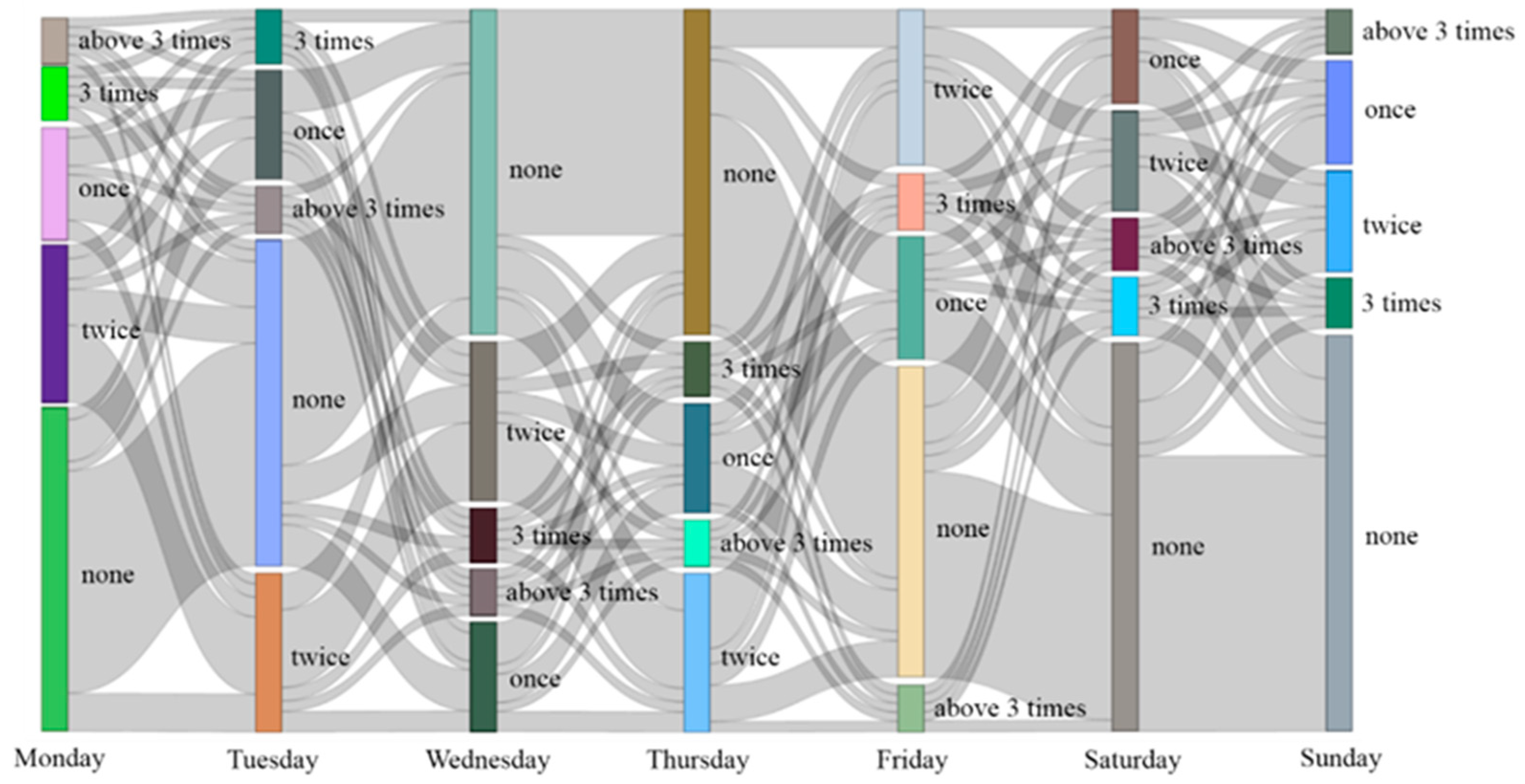
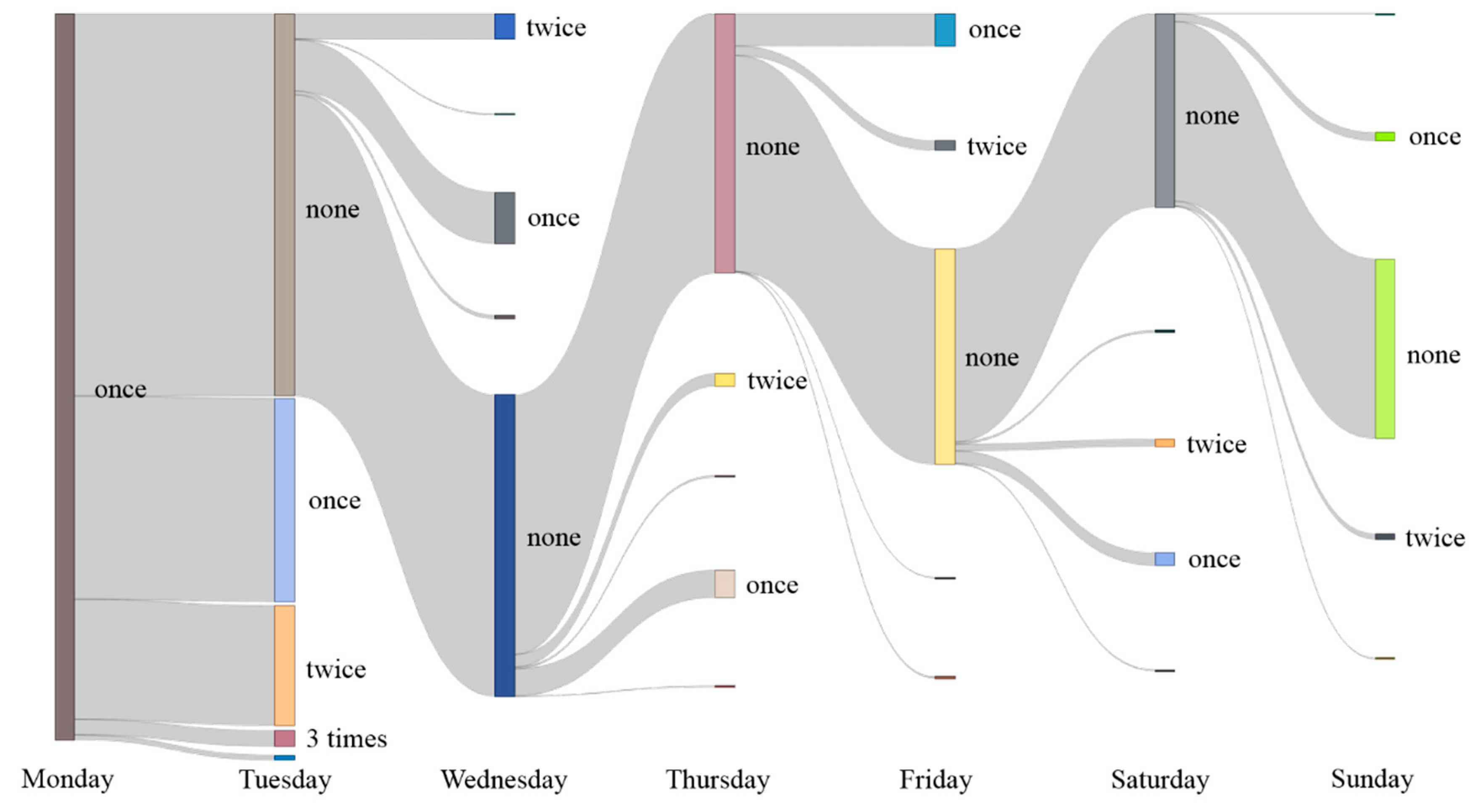
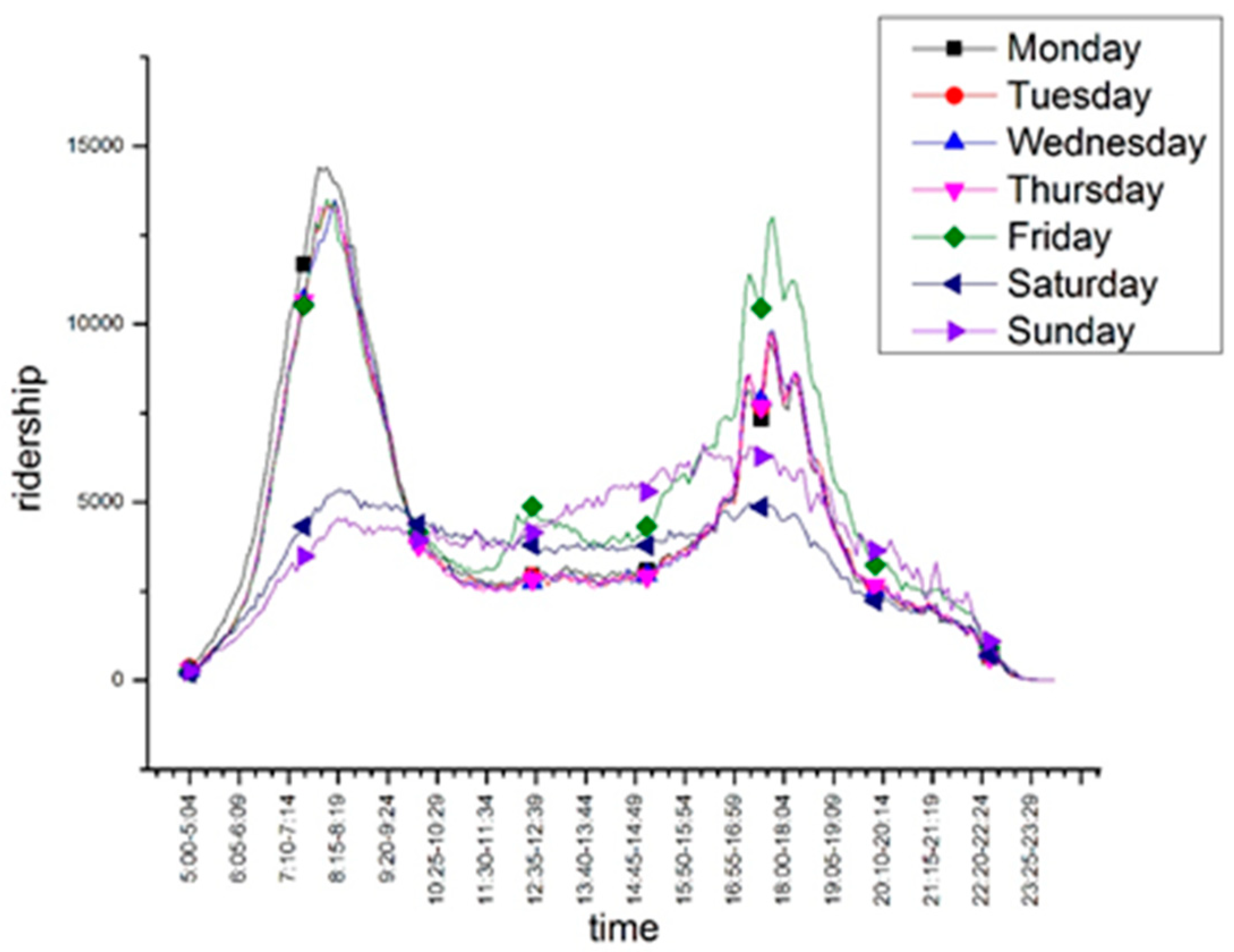

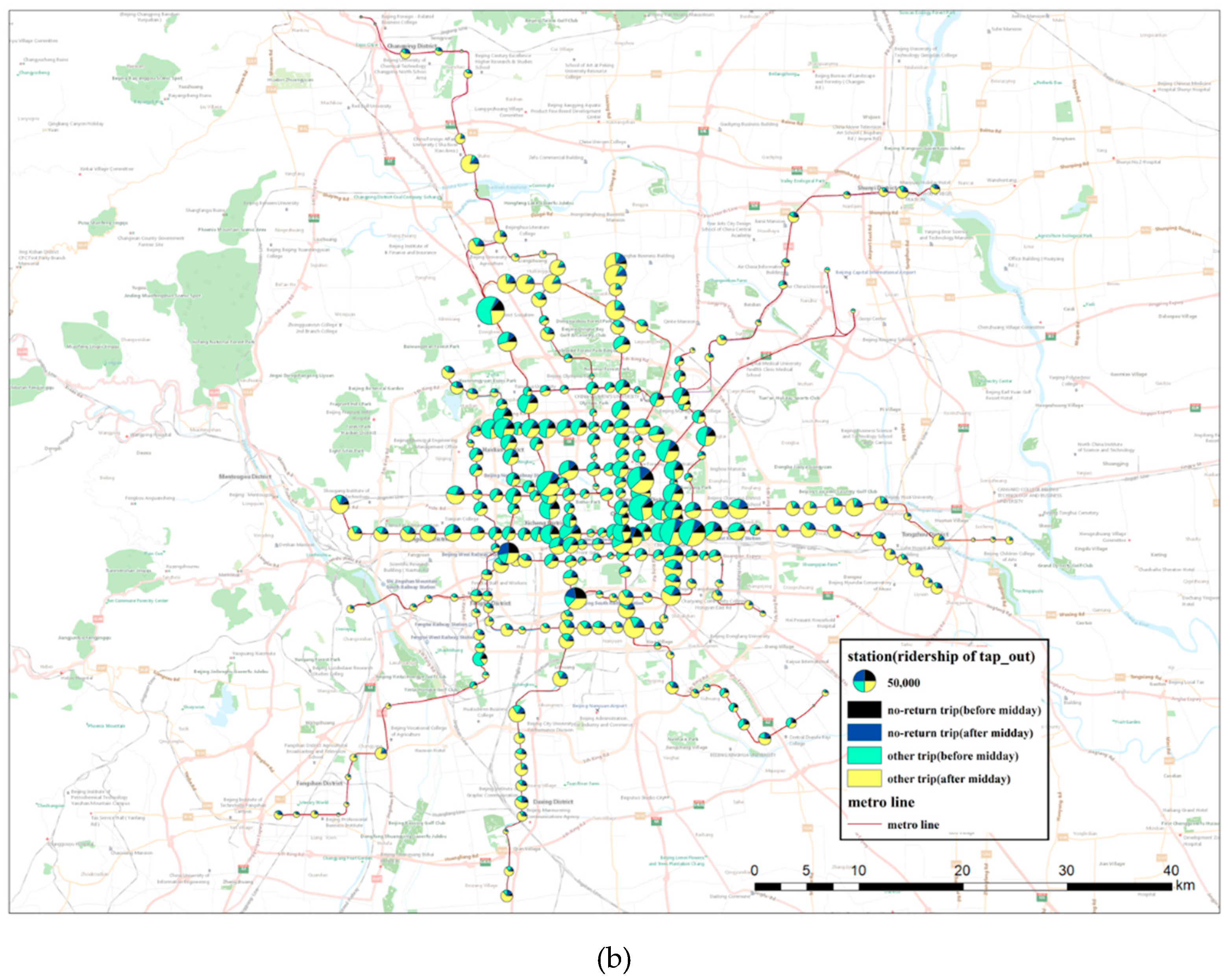
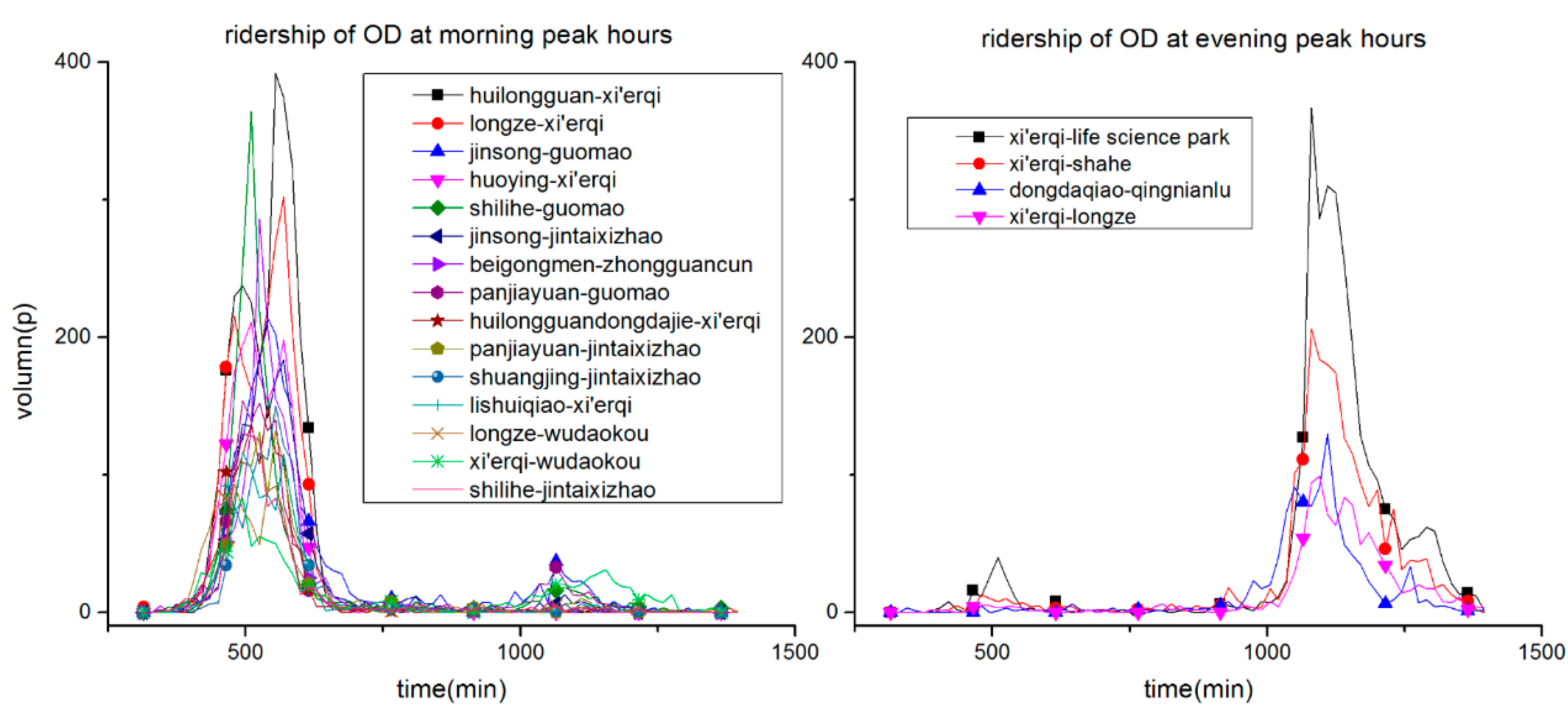
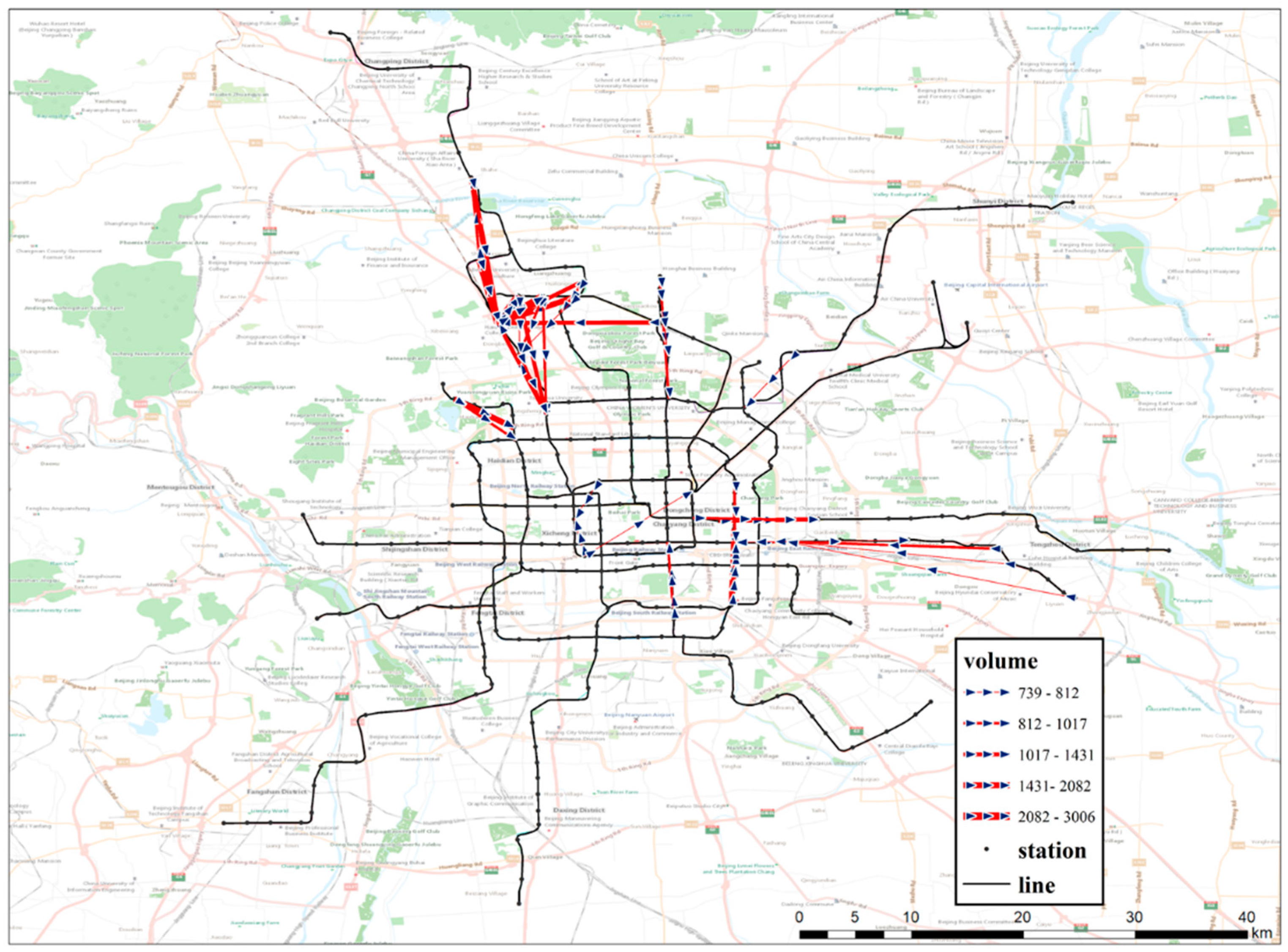
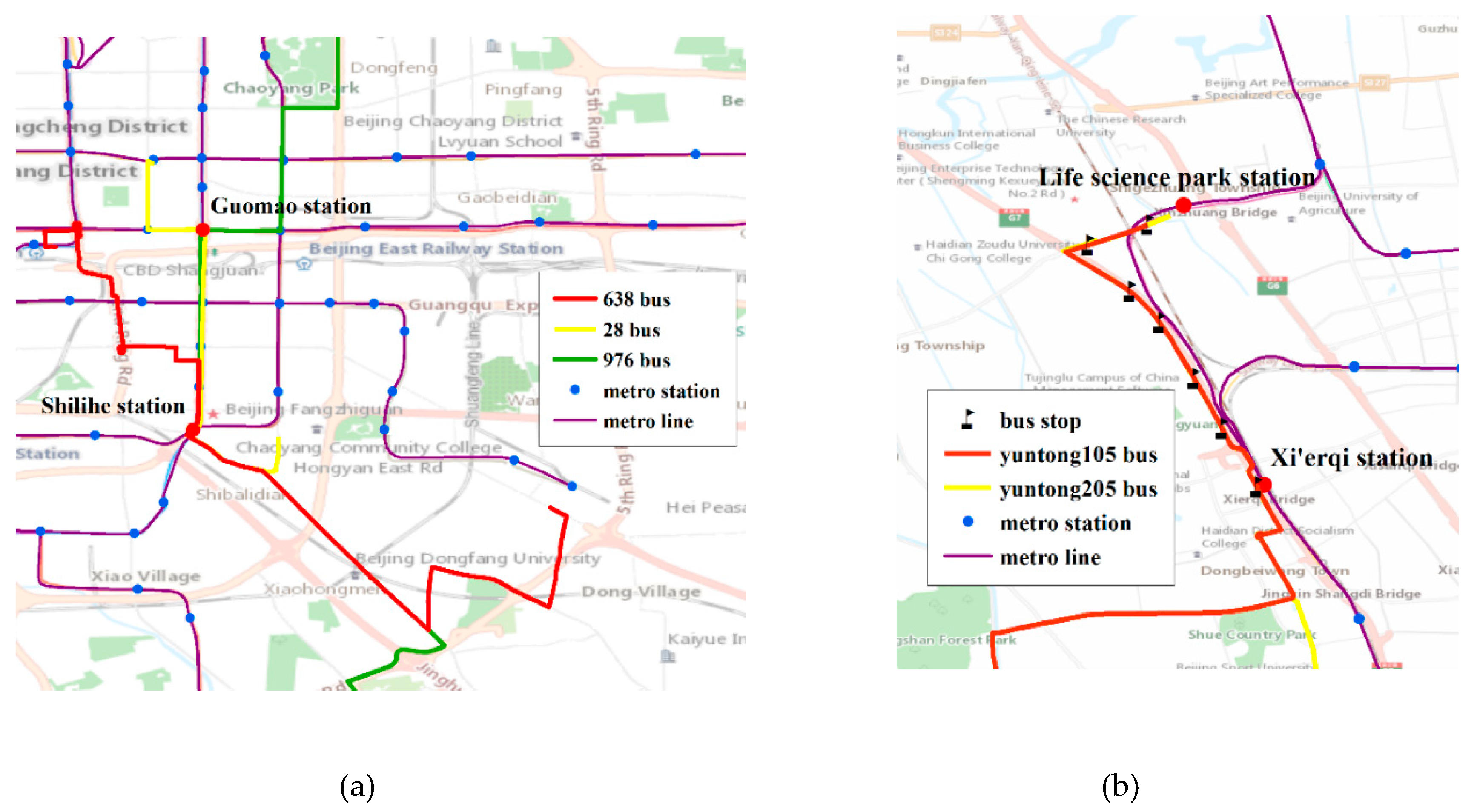
| Date | Once | Twice | 3 Times | 4 Times | Above 4 Times | Sum |
|---|---|---|---|---|---|---|
| 2/29 | 995,016 | 1,623,571 | 169,206 | 55,874 | 14,793 | 2,858,460 |
| 34.81% | 56.80% | 5.92% | 1.95% | 0.52% | 100.00% | |
| 3/1 | 946,259 | 1,640,926 | 175,889 | 57,175 | 14,911 | 2,835,160 |
| 33.38% | 57.88% | 6.20% | 2.02% | 0.53% | 100.00% | |
| 3/2 | 947,052 | 1,647,651 | 180,058 | 57,355 | 14,797 | 2,846,913 |
| 33.27% | 57.88% | 6.32% | 2.01% | 0.52% | 100.00% | |
| 3/3 | 944,391 | 1,642,546 | 176,775 | 57,509 | 14,860 | 2,836,081 |
| 33.30% | 57.92% | 6.23% | 2.03% | 0.52% | 100.00% | |
| 3/4 | 1,142,172 | 1,606,050 | 220,090 | 62,931 | 17,156 | 3,048,399 |
| 37.47% | 52.69% | 7.22% | 2.06% | 0.56% | 100.00% | |
| 3/5 | 736,695 | 824,372 | 242,870 | 103,537 | 43,189 | 1,950,663 |
| 37.77% | 42.26% | 12.45% | 5.31% | 2.21% | 100.00% | |
| 3/6 | 859,522 | 834,592 | 119,996 | 30,812 | 7408 | 1,852,330 |
| 46.40% | 45.06% | 6.48% | 1.66% | 0.40% | 100.00% | |
| Average | 938,730 36.63% | 1,402,815 52.93% | 183,555 7.26% | 60,742 2.43% | 18,159 0.75% | 2,604,001 100% |
| Trip Frequency | Ridership | Ratio |
|---|---|---|
| 1 | 2,196,133 | 67.26% |
| 2 | 659,400 | 20.19% |
| 3 | 236,878 | 7.25% |
| 4 | 115,747 | 3.53% |
| 5 | 57,747 | 1.77% |
| No. | Origin | Destination | Volume |
|---|---|---|---|
| 1 | Beijing railway station | Dongzhimen | 5284 |
| 2 | Dongzhimen | Beijing railway station | 2785 |
| 3 | Beijing west railway station | Dongzhimen | 2764 |
| 4 | Beijing west railway station | Dawanglu | 2690 |
| No. | Non-Roundtrip Frequency | Serial Number | Origin | Destination | Volume |
|---|---|---|---|---|---|
| 1 | 2 | 1 | Huilongguan | Xi’erqi | 1217 |
| 2 | 2 | Beijing railway station | Dongzhimen | 1027 | |
| 3 | 3 | Xi’erqi | Life Science Park | 913 | |
| 4 | 3 | 1 | Huilongguan | Xi’erqi | 1106 |
| 5 | 2 | Xi’erqi | Life Science Park | 894 | |
| 6 | 3 | Longze | Xi’erqi | 830 | |
| 7 | 4 | 1 | Huilongguan | Xi’erqi | 992 |
| 8 | 2 | Xi’erqi | Life Science Park | 941 | |
| 9 | 3 | Longze | Xi’erqi | 842 | |
| 10 | 5 | 1 | Xi’erqi | Life Science Park | 1171 |
| 11 | 2 | Huilongguan | Xi’erqi | 868 | |
| 12 | 3 | Longze | Xi’erqi | 755 |
| Clustering | Morning Peak | Evening Peak | |||||
|---|---|---|---|---|---|---|---|
| Serial Number | 2 | 3 | 4 | 6 | 7 | 1 | 5 |
| Origin | Huilongguan | Longze | Jinsong | Huoying | Shilihe | Xi’erqi | Xi’erqi |
| Destination | Xi’erqi | Xi’erqi | Guomao | Xi’erqi | Guomao | Life Science Park | Shahe |
| Path | Line 13 | Line 13 | Line10 | Line 13 | Line 10 | Changping line | |
| Distance (stations) | 2 | 1 | 2 | 3 | 4 | 1 | 4 |
© 2020 by the authors. Licensee MDPI, Basel, Switzerland. This article is an open access article distributed under the terms and conditions of the Creative Commons Attribution (CC BY) license (http://creativecommons.org/licenses/by/4.0/).
Share and Cite
Wang, Z.; Tang, H.; Wang, W.; Xi, Y. The Pattern of Non-Roundtrip Travel on Urban Rail and Its Application in Transit Improvement. Sustainability 2020, 12, 3525. https://doi.org/10.3390/su12093525
Wang Z, Tang H, Wang W, Xi Y. The Pattern of Non-Roundtrip Travel on Urban Rail and Its Application in Transit Improvement. Sustainability. 2020; 12(9):3525. https://doi.org/10.3390/su12093525
Chicago/Turabian StyleWang, Zijia, Hao Tang, Wenjuan Wang, and Yang Xi. 2020. "The Pattern of Non-Roundtrip Travel on Urban Rail and Its Application in Transit Improvement" Sustainability 12, no. 9: 3525. https://doi.org/10.3390/su12093525
APA StyleWang, Z., Tang, H., Wang, W., & Xi, Y. (2020). The Pattern of Non-Roundtrip Travel on Urban Rail and Its Application in Transit Improvement. Sustainability, 12(9), 3525. https://doi.org/10.3390/su12093525





